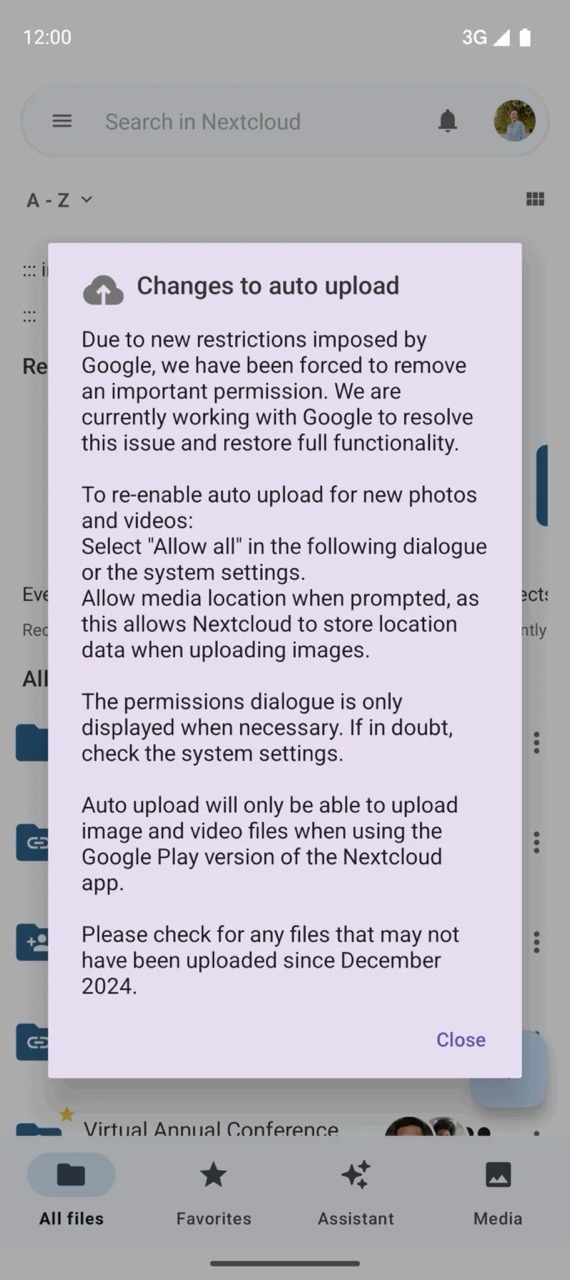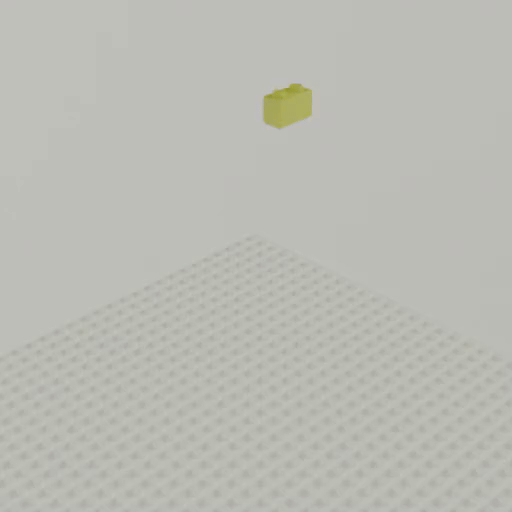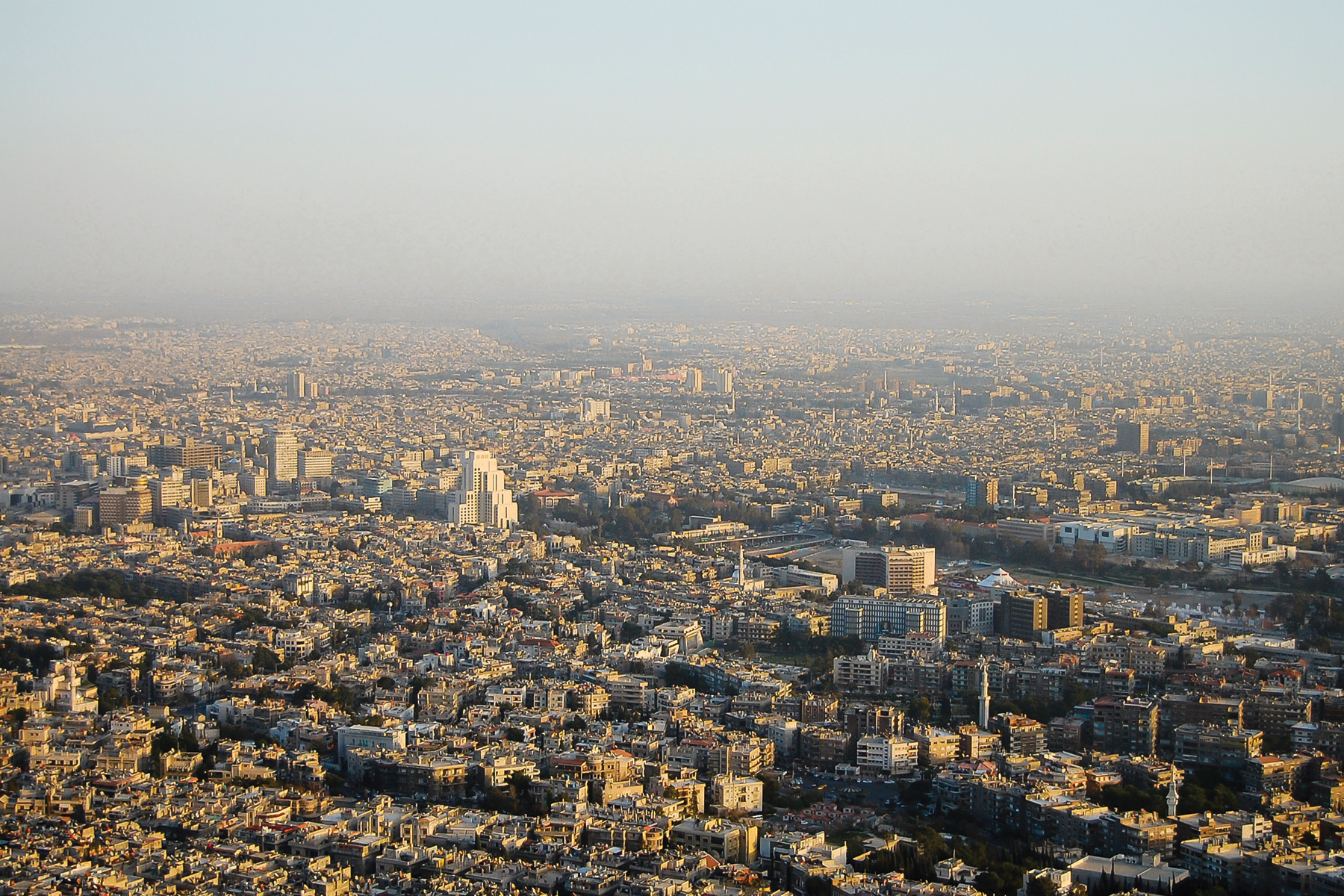
.text-block-underneath {
color: #333;
text-align: center;
left: 0;
right: 0;
max-width: 874.75px;
display: block;
margin: 0 auto;
}
.text-block-underneath h4{
font-family: “GT Sectra”;
font-size: 3rem;
line-height: 3.5rem;
}
.text-block-underneath h2{
font-size: 0.88rem;
font-weight: 900;
font-family: “Source Sans Pro”;
}
.text-block-underneath p {
text-transform: uppercase;
}
.text-block-underneath h3{
font-family: “Source Sans Pro”!important;
font-size: 1.1875rem;
font-weight: 100!important;
}
.th-content-centered .hm-header-content,
#primary.content-area {
width: auto;
}
.entry-content p,
ul.related,
.widget_sexy_author_bio_widget,
.widget_text.widget_custom_html.widget-shortcode.area-arbitrary {
margin-left: auto;
margin-right: auto;
}
.hitmag-full-width.th-no-sidebar #custom_html-45.widget {
margin: auto;
}
@media only screen and (max-width: 768px) {
.img-two-across-column{
flex-direction: column;
}
.img-two-across-imgs{
width: auto !important;
max-width: 100%!important;
padding:0px!important;
}
.main_housing,
.text-block-underneath {
margin-left: 25px !important;
margin-right: 25px !important;
}
.text-block-underneath h4{
font-family: “GT Sectra”;
font-size: 35.2px;
line-height: 38.7167px;
}
}
@media only screen and (min-width: 2100px) {
.main_housing,
.text-block-underneath {
margin-left: 32% !important;
margin-right: 32% !important;
}
}
@media only screen and (max-width: 1200px) {
.main_housing,
.text-block-underneath {
/*
margin-left: 25px !important;
margin-right: 25px !important;
*/
}
}
@media only screen and (max-width: 675px) {
.main_housing,
.text-block-underneath {
margin-left: 10% !important;
margin-right: 10% !important;
}
}
.hero-tall {display: none;}
.hero-wide { display: block; }
@media (max-width:700px) {
.hero-wide { display: none; }
.hero-tall { display: block; }
}
What Would It Take to Rebuild Syria?
After fourteen years away, I returned to a home I barely recognized
Published 6:30, MAY 13, 2025
The singing and clapping burst forth before the plane started moving. “Raise your head up high, you’re a free Syrian,” a group of passengers a few rows ahead of me chanted in Arabic. The song has become a classic in the months since the fall of the Bashar al-Assad regime in Syria last December. A few passengers—some draped in Syria’s new flag, a symbol of anti-colonial and anti-al-Assad uprisings—took turns playing the tune on their phones, along with a few other victory anthems, and called on other passengers to join in. I clapped along in giddy bewilderment. Just three months earlier, I kept thinking, this could have gotten us all killed.
Under the autocratic rule of Hafez al-Assad, who seized power in 1971 following a military coup, and his son and successor, Bashar, any whiff of dissent meant prison and torture. Most Syrians didn’t express their political views beyond a tight circle, and even then, we often spoke in code. We never knew who might be part of the secret police or an informant. In public, we either loudly praised the al-Assads or kept quiet.
Like me, many of those on the flight that February morning, from Doha, Qatar, to Damascus, Syria’s capital, were returning to the country for the first time after a fourteen-year war. Several passengers declared it loudly, their tone a mix of joy and grief that captured my own feelings about the trip.
Aside from seeing family, I was eager to soak in as much as I could of the country’s impossibly fragile moment. I wanted to hear from Syrians who’d lived through the war about how they felt now and what they thought it would take to move forward and rebuild. Since I had only a week, I decided to stay in Damascus—it’s where I grew up. For me, it’s still home.
The celebrations resumed as our flight landed. When I walked out into the arrival hall, many of those waiting carried flowers and Syria’s new flag, and strangers called out greetings. But as I left the airport and a family friend drove me into town, euphoria gave way to reality.
The war in Syria was triggered in March 2011, in the southern city of Daraa. A group of teenagers was arrested and tortured on the charge of spray-painting anti-al-Assad graffiti on a school wall. That January, popular uprisings had overthrown authoritarian governments in Egypt and Tunisia, and a wave of pro-democracy movements rippled across North Africa and the Middle East in the period known as the Arab Spring. When locals took to the streets in Daraa, calling for the kids’ release, their protests grew into demonstrations for broader rights and freedoms that quickly spread across the country.
Al-Assad ordered his forces to arrest and shoot at protesters, and in April, the military laid siege to Daraa—tactics that would be repeated in other cities. In May, footage circulated online of the tortured and mutilated body of Hamza Ali al-Khatib, a thirteen-year-old from Daraa who’d been detained after attending a protest. It fuelled further outcry.
During those initial weeks and months, al-Assad promised limited reforms but largely blamed the unrest on the media and foreign actors bent on destabilizing the country. Throughout the war, the regime would continue to circulate propaganda painting the opposition as radical Islamists and terrorists.
The playbook was familiar; to maintain their hold on power, the al-Assads had long claimed that their secularist regime protected minorities, most notably Christians and their own Alawite sect, in the Sunni-majority country. Their policies also favoured Alawites and loyalists, placing many in high government positions or rewarding them with lucrative contracts—a fact that’s created widespread resentment against Alawites in particular.
While the revolution started out as peaceful, some protesters began arming themselves in the summer of 2011. Over the following years, multiple rebel factions emerged, including the Free Syrian Army, a loose coalition formed largely of military defectors, and Jabhat al-Nusra, an al-Qaeda affiliate.

The armed rebel groups battled the government and gained control of parts of the country—some with support from foreign powers, including Qatar, Turkey, Saudi Arabia, and the United States. Iran, the Lebanon-based militant group Hezbollah, and Russia stepped in to prop up the regime. In some pockets, non-violent, non-sectarian resistance persisted.
The war spawned unthinkable horrors: an estimated death toll of more than 600,000; at least 150,000 arrested and arbitrarily detained, including thousands of children; chemical attacks, massacres, and sieges against rebel-held areas; heavy aerial bombardment; the targeting of hospitals. In 2013, the Islamic State was formed and went on to seize power in and terrorize northeastern Syria. It was defeated mostly by US-backed Kurdish groups in 2019.
In 2020, following military escalations along Syria’s northern border, Russia and Turkey negotiated a shaky stalemate. Some Arab states had by then started normalizing relations with al-Assad. For a while, it looked like he’d won.
Over the course of the war, more than 6 million Syrians fled, and 7.4 million are thought to be internally displaced. (The World Bank estimates the total population to be at 23.5 million, but there are an untold number of Syrians born abroad who haven’t been registered in the country.) In February 2023, devastating earthquakes in Turkey and northern Syria compounded the humanitarian crisis, killing more than 55,000 and levelling infrastructure.
Last November, the tide suddenly turned. Russia was focused on its ongoing invasion of Ukraine, while fighting with Israel over the past year had debilitated Iran and Hezbollah. On November 26, Hezbollah and Israel signed a ceasefire in Lebanon, severely weakening the militia’s reach.
By this point, Jabhat al-Nusra had evolved into Hayat Tahrir al-Sham, or HTS, which controlled parts of the northwestern Syrian province of Idlib. The day after the Hezbollah ceasefire, HTS began a military advance that eventually veered southward, pushing government forces to flee or retreat. In less than two weeks, HTS took control of major cities and small towns along the way, cutting Damascus off from outside support. On December 8, they reached the capital, where another rebel group from the south had already breached the city. That morning, news broke that al-Assad had fled. The regime was done.
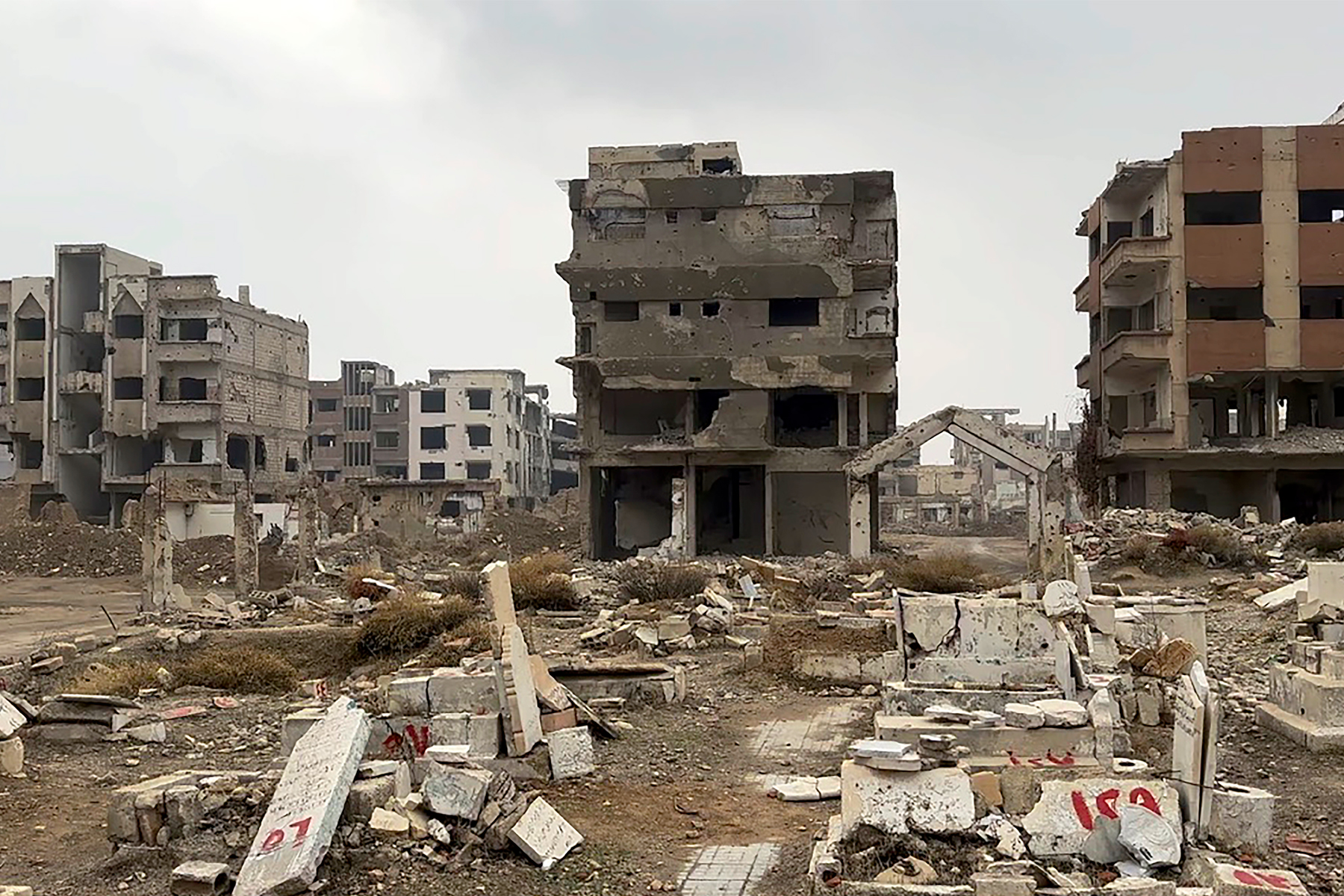
Many Syrians remain skeptical of HTS due to its Islamist core and reports of its authoritarian rule in Idlib. HTS leader Ahmed al-Sharaa, who is responsible for atrocities such as coordinating suicide bombings, has sought to distance himself from his extremist past since taking power as interim president. He’s spoken about the importance of protecting women’s rights and minorities. After years of conflict, Syria’s diverse religious and ethnic communities—Muslims, Christians, Alawites, Druze, Kurds, Assyrians, Armenians, Ismailis, Circassians, and others—must find a way to coexist.
In late March, al-Sharaa introduced a transitional government; observers have noted that some of the twenty-three cabinet appointments, with one Alawite, one Druze, and one Kurdish minister, were clearly intended to gesture toward inclusivity. Hind Kabawat, a lawyer and founder of the Toronto-based Syrian Centre for Dialogue, Peace, and Reconciliation, is the only woman and only Christian in the cabinet, serving as the minister of social affairs and labour. Earlier in the month, al-Sharaa had put into effect a temporary constitution, which would remain in place for five years, until elections can be held (though, like the previous constitution under al-Assad, it stipulates that the president has to be Muslim).
Even if al-Sharaa manages to deliver on his promises, the challenges ahead are gargantuan. The new government will have to, among other things, restore public services, revive the shattered economy, unite regional militias and build a national army, pursue justice for war crimes committed, resist Israel’s unlawful incursions into contested territory and escalating military aggression, and rebuild infrastructure to repatriate displaced Syrians. And that’s just a start.
There’s not enough money in the country to do any of that. While al-Assad was in power, his family drained government coffers of millions of dollars and sent the money abroad, including to Russia, where the former president is now in hiding. Inflation has run rampant. Around 90 percent of the population lives below the poverty line, according to United Nations estimates.
While some countries, including Qatar, have promised to support Syria’s economic revival, they’re hampered by Western sanctions against the Syrian state and al-Sharaa. In May, the US reportedly approved a Qatari plan to temporarily finance Syrian public sector salaries. Several countries and the UN still designate HTS as a terrorist organization. (Al-Assad had weathered the sanctions in part through the state-sponsored trade of Captagon, an illicit drug that’s become popular in the Middle East.) The sanctions collectively target financial institutions, energy, and telecommunications, restricting foreign investment and the work of aid groups, despite some exemptions for humanitarian assistance. As of early April, some sanctions had been lifted. But the economy remains paralyzed.
In Syrian Arabaic, the word for tired is taaban. It means more than physical fatigue. It can also mean unhealthy, unwell, rundown, neglected. That’s how everything appeared as I drove into the city: the roads, sidewalks, buildings, sparse greenery—all of it taaban.
Throughout my week-long visit, I kept hearing a similar refrain: prices of some groceries have dropped slightly since the fall of the regime, but it doesn’t matter much, because there’s hardly any work and no money. Many civil and public servants have either been dismissed or haven’t received salaries in months. The banks are short on cash. A common complaint while I was there was that customers weren’t allowed to withdraw more than 200,000 Syrian pounds at a time, or the equivalent of about $22. Shortly after I left, the restrictions changed, allowing a single transaction of 500,000 Syrian pounds per customer—once a week.
Any transactions that do go through can be delayed by relentless power cuts. These happened fairly regularly even before al-Assad’s fall. In many areas, electricity now comes on just twice a day, typically for no more than ninety minutes at a time—though the timing and duration remain unpredictable. For alternative power sources, many buildings and traffic lights are topped with solar panels, and street vendors sell gasoline from giant bottles to fill up cars.
While driving was always chaotic in Damascus, it now defies belief. During my visit, there were hardly any traffic cops and zero rules. I spotted the occasional volunteer in an improvised uniform waving vehicles along, but they seemed to carry little authority. Driving is even more nerve wracking at night, when it gets especially dark because the street lights are out. On sidewalks, I saw pedestrians guide their way with cellphone flashlights.
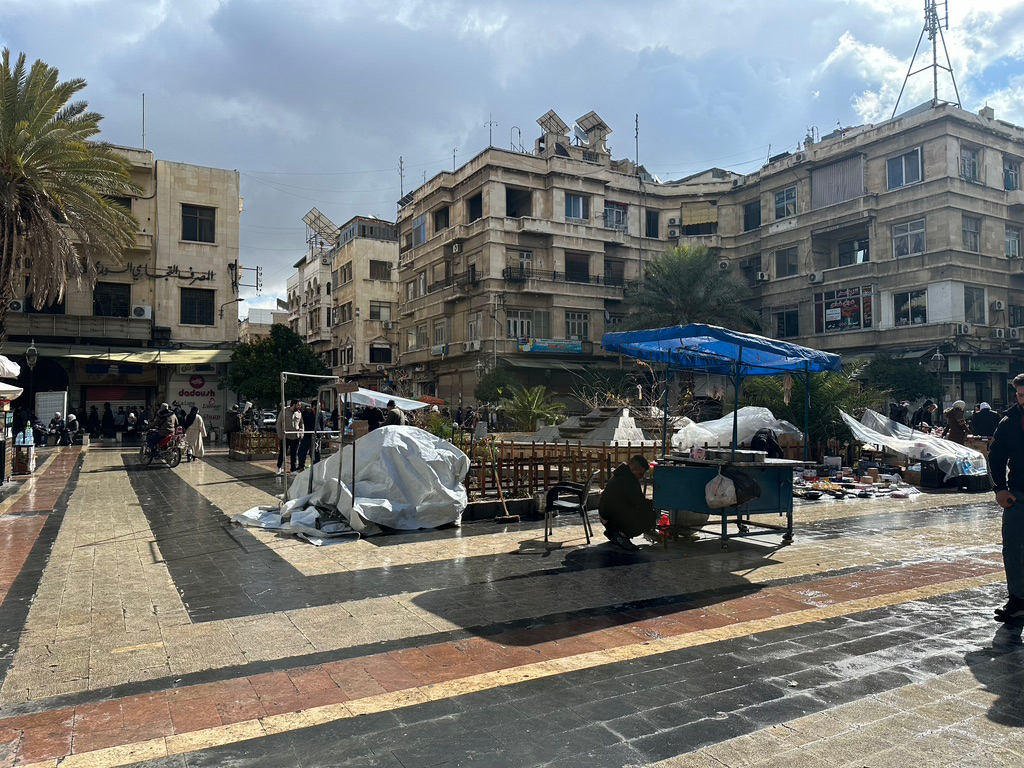
Despite the hardship, there’s an undercurrent of optimism. From coffee trolley vendors to shopkeepers, people I spoke with said they hoped conditions would soon improve. The general relief at Bashar’s ouster was visible in the graffiti, which alternated between cursing him and celebrating his departure—and in the marked absence of giant posters and statues of him and his father, which once towered over the city pristinely while everything around them crumbled in neglect. Now, the only effigies of the al-Assads I could see were caricatures on the soles of socks for sale at the Souk Al-Hamidiya, a covered market in the Old City.
Yet tensions remain high. Regime checkpoints once terrorized residents: getting held up there could mean being interrogated and potentially detained. Now, some HTS soldiers are stationed throughout the city, mainly at the few remaining checkpoints, where they ask drivers whether they’re carrying weapons. (The interim government has been calling on former al-Assad fighters to give up arms.) To me, they looked more like the rebel fighters they were trained to be rather than trusted local authorities. Amid what’s been described as a security vacuum, kidnappings in parts of the country, usually for ransom, have further stoked fears of more bloodshed.
Echoes of the war are everywhere. After the fall of al-Assad, thousands of detainees were released from the country’s notorious prisons; many of them had been arbitrarily arrested. Outside a building near Damascus’s Old City, I saw a flyer printed with a screenshot of a social media post featuring a blurry image of a man’s face and torso. “This person is my cousin,” the text said. “He was taken on January 7, 2013, and he appeared in video footage from Saydnaya prison . . . on December 8, 2024.” A phone number followed for anyone who had knowledge of the man’s whereabouts.
The Syria Civil Defence, more widely known as the White Helmets thanks to their iconic headgear, moved into an old fire station in Damascus on December 9, the day after the regime fell. The group has provided emergency services in rebel-held areas across the country since its founding in 2013, having grown out of scattered volunteer-led efforts to rescue, often with their bare hands, those trapped under the rubble after regime attacks.

In addition to providing front-line services, the White Helmets have done some rebuilding work. Alongside other organizations, they’re identifying land mines and unexploded ordnances—any weapons that may still be on the ground without having detonated—and clearing them so that displaced Syrians can return home. (White Helmets founder Raed al-Saleh has been named minister of environment, emergencies, and disaster management in the transitional government.)
One of the group’s current priorities, says Ismail Alabdullah, a co-founder who now serves as media coordinator, is to verify the identities of war victims. It’s one of several projects undertaken by Syrian civil society groups and international organizations to pursue justice for the regime’s war crimes. For the White Helmets, this effort will require gathering DNA samples from human remains, some found in mass graves, and matching them with the DNA samples of survivors whose missing family members are still unaccounted for.
To that end, some White Helmets members have received forensics training in Guatemala and Rwanda, where similar work has been done in the wake of atrocities. But the White Helmets don’t even have a forensics lab yet, says Alabdullah. The effort will take years.
Alabdullah was previously based in rebel-held northern Syria, which was in many ways better off than the regime-controlled capital, because of its access to trade with neighbouring Turkey. When I asked him what he thought of Damascus, he said he longed for the poverty to ease: “The people of Damascus,” he said, “are taabaneen.”
The air felt thick with car exhaust as Saeed Salha drove me to Jobar, a formerly rebel-held neighbourhood on the eastern edge of Damascus. Salha is a videographer and photographer for Syria Relief, a humanitarian organization run by the UK-based Action for Humanity. We were accompanied by Abdul Rahman Edris, who works for a local media office and monitors outsiders’ visits to Jobar.
Known as the Eastern and Western Ghouta, the capital’s suburbs encompass several enclaves where migrants from other parts of the country—many driven from rural areas by a chronic drought—settled in the years before the war broke out, often alongside Palestinian refugees, leading to tensions and overcrowding. These neighbourhoods also sprouted some of the most dedicated movements against al-Assad at the start of the uprisings. By November 2012, rebel groups had driven out government forces in several areas. Then came retaliation.
On August 21, 2013, rockets hit towns in Eastern and Western Ghouta. They contained what investigators later determined to be a nerve agent, likely sarin gas, which poisoned and suffocated an estimated 1,119 civilians, according to the Syrian Network for Human Rights. (While the regime denied responsibility, various reports, including one by Human Rights Watch, concluded the weapons used likely came from the Syrian government’s armed forces.)
Following a UN investigation and Russian intervention, Syria nominally joined the international Chemical Weapons Convention and agreed to dismantle its stockpile. And yet the regime went on to launch dozens more chemical attacks, using agents like chlorine and mustard gas, in rebel-held areas across the country.
The army’s assault continued for years after the chemical attacks, with Jobar being one of the last holdouts. In 2018, regime forces launched a brutal military campaign that reduced most of the area to rubble and drove out what remained of the resistance.
Salha, who’s now twenty-eight, pointed out where his old house used to be as we drove into the neighbourhood and stepped out to walk. Looking at the destroyed buildings, I realized everything around me would have to be demolished, likely by specialized crews, before anything could be rebuilt. In the years after rebel forces evacuated, looters, many of whom were from the Fourth Division in al-Assad’s army, gutted the ruins to salvage metals and any other sellable materials—including gold and jewellery left behind.
There was still an unexploded rocket in one of the larger mosques. (It was safely detonated on March 24.) The Eliyahu Hanavi synagogue, thought to date back 2,700 years, has been destroyed and looted. The resistance, too, has its landmarks: Salha led me down into a segment of a five-kilometre-long tunnel system that sustained rebels during the siege, connecting them to other opposition towns in Eastern Ghouta and allowing them to smuggle in food and other supplies.
I knew the damage went far beyond what I could see around me. As we walked, I asked Salha and Edris about their experience of the chemical attacks. Salha, who was sixteen at the time, recalled how the mosques broadcast a warning in the middle of the night. Most people, he said, didn’t know what a chemical attack meant or what to do.
“My sister died in the chemical attacks,” Edris added quietly. He was living with his parents in an area that escaped most of the fumes. They went out in search of his sister as soon as they could and found people who’d collapsed on the stairs leading to their basements. Many were accustomed to going into hiding below ground during air strikes, not realizing the chemical fumes were denser than air and would therefore sink. Edris’s family found his sister’s children and buried them, and hours later, they found his sister in the hospital. She was dead. Her husband and his family were all killed.
Some of the victims were never identified, Salha said, so they were photographed and buried in mass graves. He reckoned some might have still been alive. “And that was the experience, in general,” said Edris.
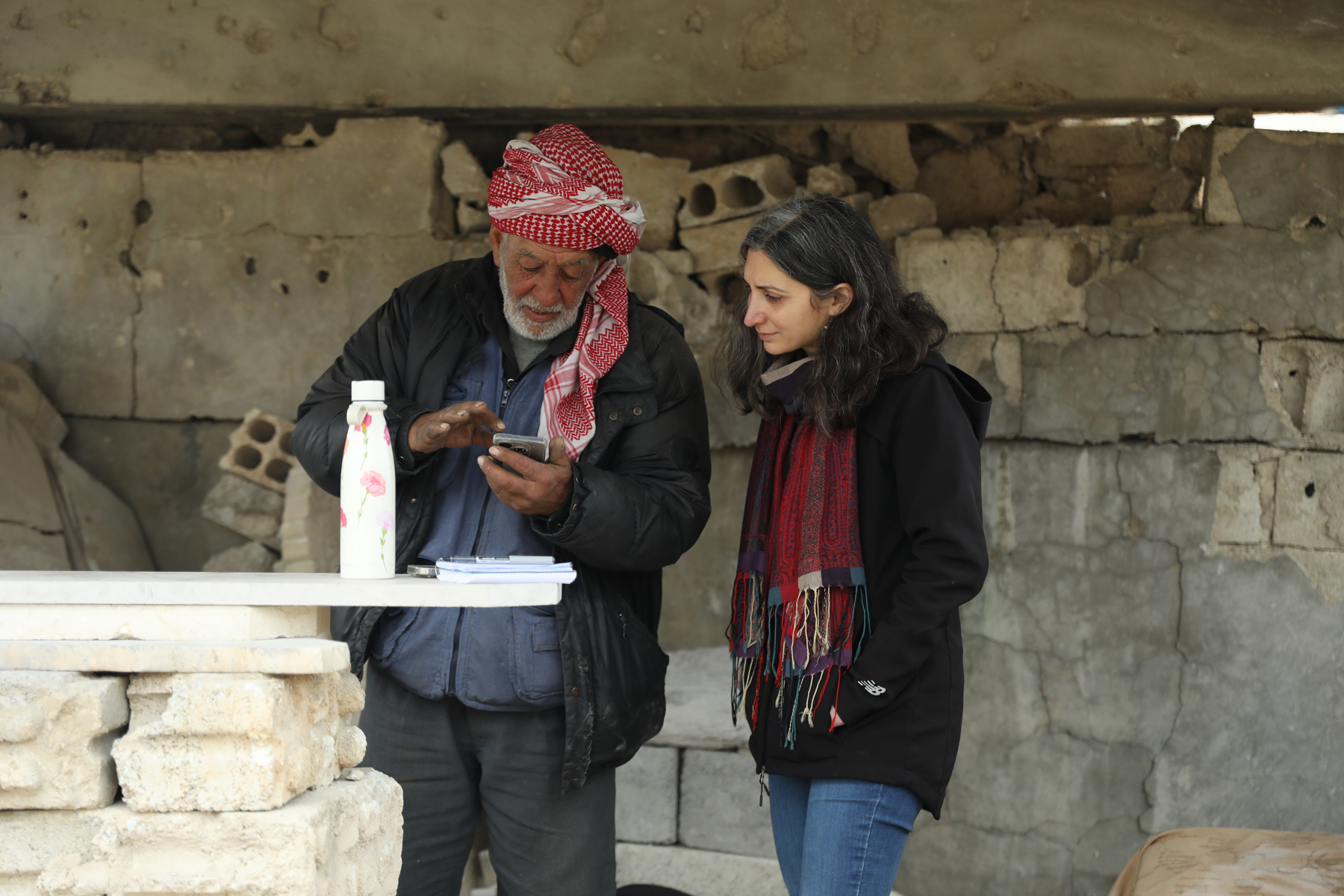
Around us, Jobar was mostly empty, but here and there were signs of life. Two kids passed nearby with a herd of goats. A pair of young men drove around on a motorcycle. Salha pointed out the cemetery, where many of the tombstones were damaged.
The undertaker, Abu Fahed, was there. Now sixty-six, he’s buried thousands of victims, including twenty-three members of his own family. Abu Fahed and his son Fahed (Abu Fahed means father of Fahed) both worked in the local opposition’s civil defence force during the uprising, in addition to overseeing burials. When his son was killed in an air strike in November 2015, Abu Fahed buried him. He also lost his daughter Mona, her husband, and one of the couple’s sons on the night of the chemical attacks. Their other son, then eight years old, survived and is now one of six orphans who, for a while, lived with Abu Fahed and his wife. Abu Fahed still spends his days at the cemetery, where former residents come by to ask where their relatives are buried.
“I’m an encyclopedia,” Abu Fahed told us, sitting in the shell of a hut on the cemetery grounds. He showed us some of the notebooks where he keeps his records, as well as a clear, crumpled plastic bag that he pulled out of his pocket. It was filled with loose sheets of paper, each containing more lists of the names of people buried in various graves, the cause of their death, and, in some cases, who their father was.
When I asked him about his hopes for Jobar, he said he wanted to see it returned to the way it once was. People used to bring picnics to these grounds, he said. “This cemetery was heaven.”
In another part of town, we came across two brothers, Hossam and Hassan Fayoumi, who were digging through a pile of rubble, trying to get whatever metal they could find. This was once their old home, which Hossam said was still standing when he last visited five years ago. Jobar used to be beautiful, he said, with people of various sects and backgrounds living side by side.
When Hossam and his family recently came to visit, his daughter said she barely recognized the city. “‘Jobar is broken,’” he recalled her telling him. “Jobar is broken,” he said to her, “and the people are broken too.”
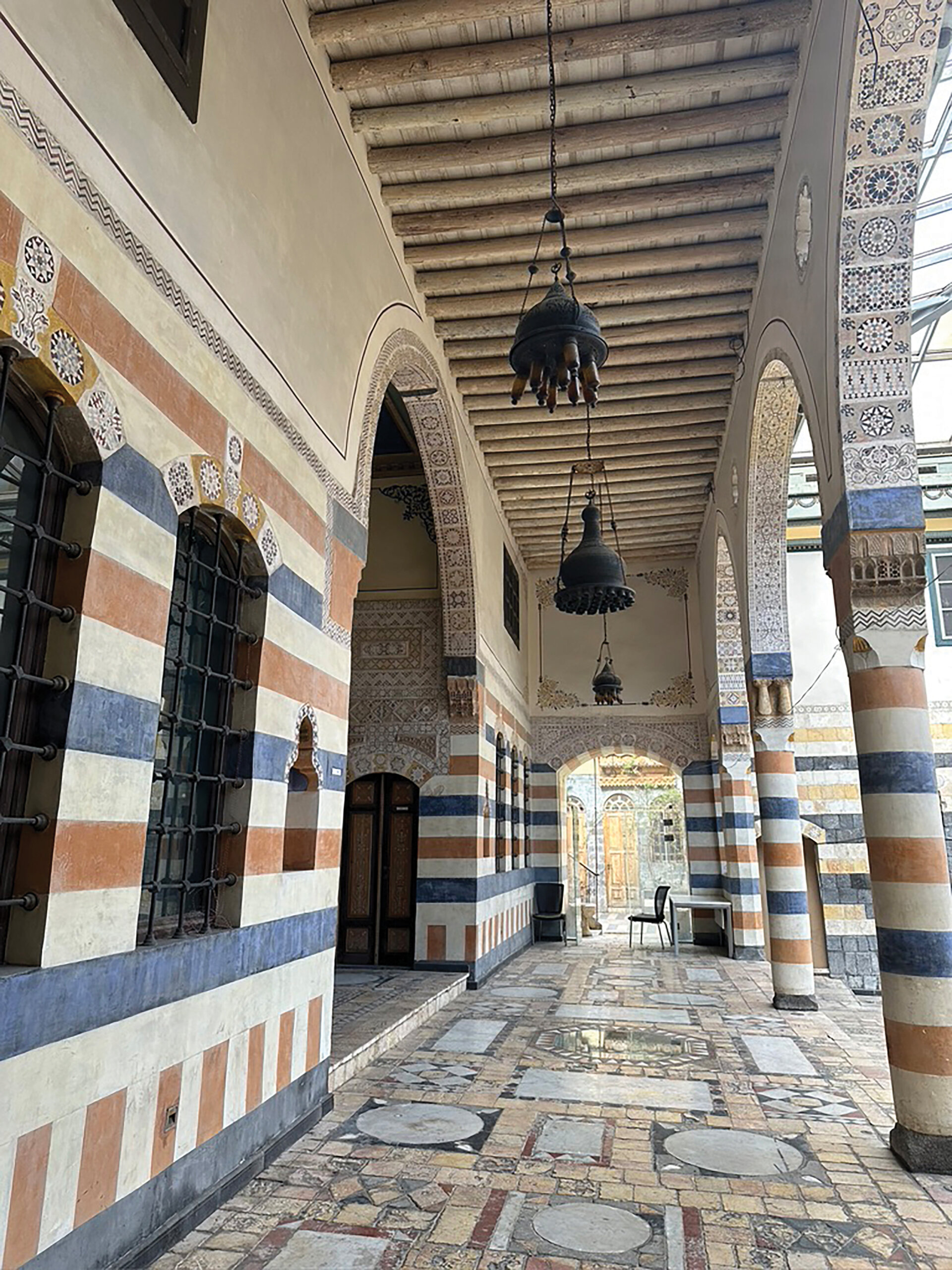
The next day, I was driven past an old checkpoint to the town of Daraya, in Western Ghouta. It is said that near Daraya is where the apostle Paul fell on the road to Damascus and converted to Christianity. More recently, Daraya was known as a hub of peaceful resistance when protests began in 2011. One memorable campaign included handing out bottles of water and roses to government soldiers. Though some residents joined a branch of the Free Syrian Army during the uprising, the enclave’s affairs were run by a local coordination committee, part of a satellite of non-violent, non-sectarian opposition groups across Syria.
In August 2012, the regime launched air strikes and carried out a massacre that, activists estimate, killed between 500 and 700 civilians, including children. The army shelled the area, then went door to door, pulling out civilians and shooting or stabbing them to death. A few months later, government forces surrounded Daraya with checkpoints in what would become a four-year siege, largely cutting off any food or aid supplies. The population shrank from about 350,000 to 120,000 as residents fled. In 2016, the rebels and the government negotiated a surrender, and opposition fighters were allowed passage to rebel-held territory in Idlib.
As in Jobar, any buildings that remain are at least partially destroyed, with gaping window frames and concrete blocks hanging precariously off the sides. Entire housing developments have been razed. And yet there are families who have made their way back in recent years, moving into any rooms in their homes that might still have walls and a ceiling, some covering up window or door openings with rugs to keep out the cold.
Refaat Mahmoud, who was nearly executed during the massacre, left Daraya in 2016 and returned three years later. For the past twenty years, he’s served as executive director of the Islamic Charitable Association in Daraya, where he focuses on distributing aid to orphans, seniors, and families caring for people with illnesses and disabilities. The association was founded in 1974, before which, he said, there weren’t many civil society groups operating in Daraya. But in recent decades, they’ve increasingly worked to fill the gaps where government services failed or were non-existent.
Now, said Mahmoud, the town is entirely run by a civil administration, with a communications branch and services for youth, women, and seniors. The law enforcement division is locally staffed. “We haven’t had a single issue since the fall of the regime,” he said. Fifteen of Daraya’s twenty-six public schools are also running. Mahmoud suspected more former residents would move back this summer, when the weather is warmer and schools are out.
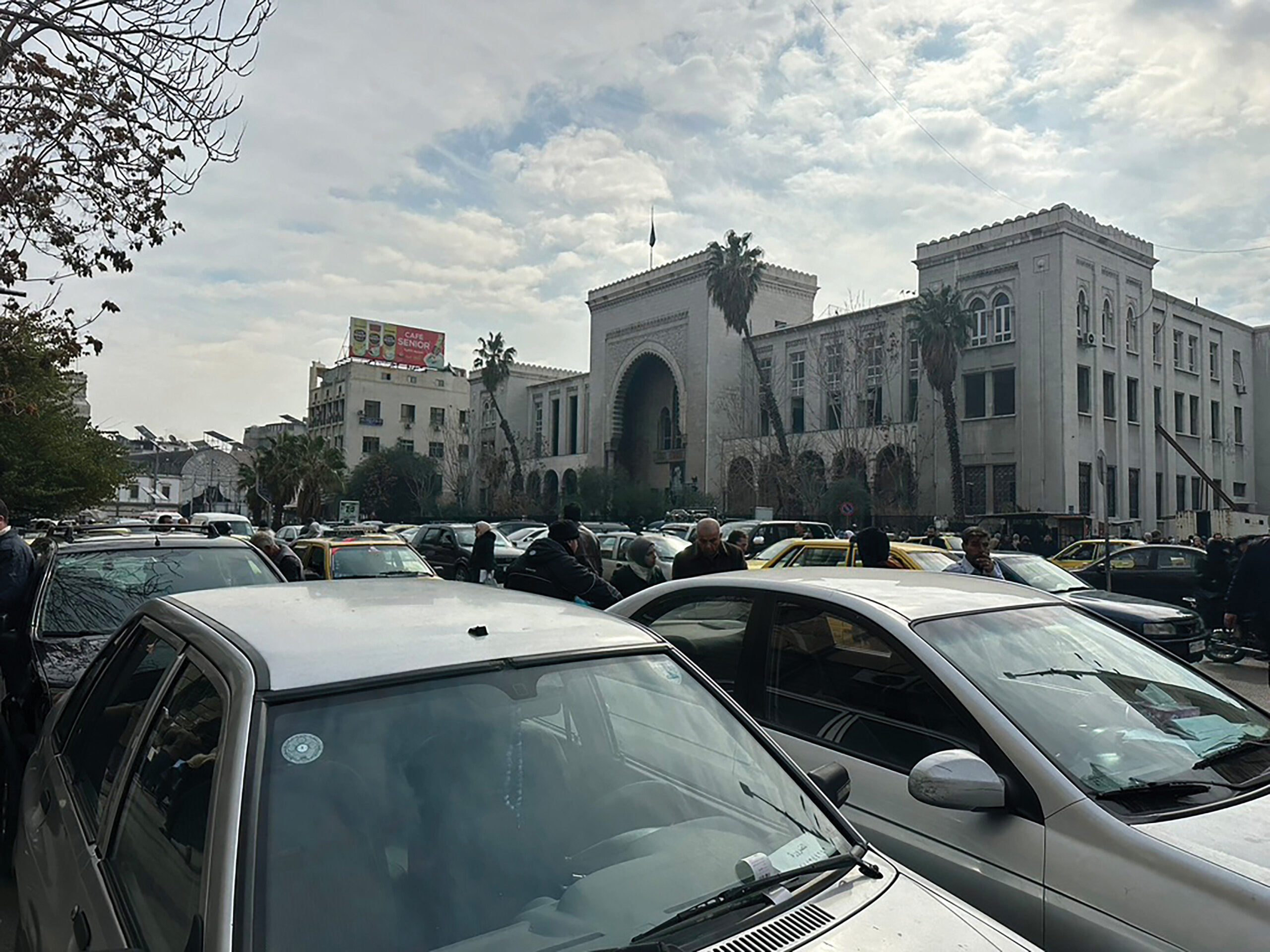
A number of outside organizations have visited Daraya since the fall of al-Assad, looking to establish development projects. In preparation, a local team is gathering data about the town’s demographics. But so far, there are only two new charities that have launched operations. Around the corner from Mahmoud’s office is a room rented out by the International Network for Aid, Relief and Assistance—INARA—a nonprofit founded by journalist and former CNN correspondent Arwa Damon to provide medical and mental health care to children affected by war. (INARA can mean illumination in Arabic.)
As part of its programming in Daraya, INARA hosts daily group therapy sessions for women. The day I visited, Rahaf, a psychologist, led a discussion on self-care. (She asked to use only her first name.) There were around ten women in attendance, all of them widows, seated in plastic chairs in a circle around a stove.
Prompted by Rahaf’s questions, they talked about the pressures they faced filling the roles of both parents. Some of their children are afraid of loud noises. One woman described how, when there’s gunfire—which might just be during a wedding, when it’s customary to shoot a gun in the air—her fourteen-year-old daughter, who was a baby when the family fled Daraya, now hides behind a door. Another said her children are withdrawn and don’t want to visit their grandparents or friends.
After the workshop, some of the women agreed to speak with me. Kafa al-Khatib told me she’s had to burn garbage and old clothes to keep her stove running. “Imagine spending weeks without blankets,” she said. “It sometimes feels like we’re living in a refrigerator.” Randa Natoor said that when air strikes began hitting Daraya, she and her husband and daughters fled the house barefoot. To this day, they have almost nothing.
Nadia Othman, whose home was destroyed and who is now living with her brother’s family, said she longs to be able to rest. Another participant said those who haven’t been able to move back into whatever’s left of their old homes are forced to pay rent they can barely afford. With no electricity to keep the lights on, their children can’t complete their homework in the evenings. Most go to sleep after sunset, because there’s not much else to do.
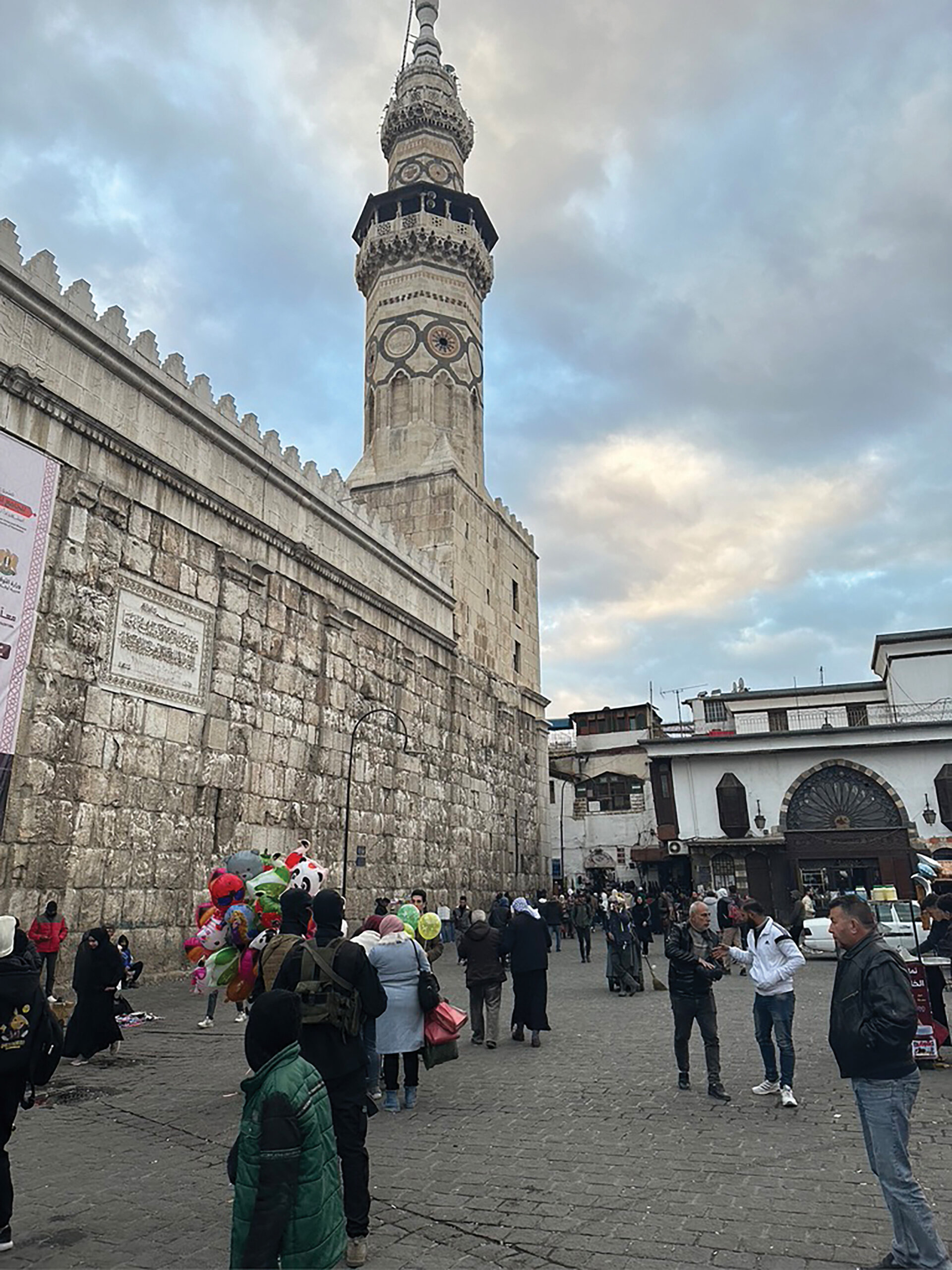
The women were eager to talk. But I understood that they were barely scratching the surface. Rania Hamada, who works as a janitor and caretaker at the association and spoke to me while I watched the session, told me, “It’s not that we forget. But it’s hard to speak about everything.” Her younger son, who’d been forced to join the regime’s army, had fallen ill after a year of service. He’d died just fifteen days earlier.
After the women’s session was up, some kids trickled in; school was out for the day. The space was meant to allow them a chance to express themselves, Rahaf told me. A few girls sat down to draw. The walls around them were covered in a mural painted by local children and women. There were also drawings hung on the walls, most with similar motifs: houses, flowers, and the words “Free Syria.”
I wondered how each of these children felt about Daraya—whether they even considered it home. They weren’t old enough to remember the town before the war. Earlier, I asked Muhammad Elemam, INARA’s program officer, and Refaat Mahmoud if there were any plans to preserve memories of the uprising and the war. Elemam told me he envisioned a museum, with photos, videos, and other documentation of the revolution.
Mahmoud smiled at me patiently. “The truth is, the people have lived under severe pressure and, you could say, psychological crises,” he said. The idea Elemam had outlined was very nice, he said—genuinely so —“but most people aren’t thinking about that now. We lived through it for years, not just a day or two. There’s not a family here without a martyr or someone who was imprisoned or disappeared or who now has a permanent disability.” Unless an interest group with the right expertise takes on such a memorial project, he said, it simply won’t happen.
Rania Jamaluddin, one of the women at the support group, invited me to visit her home to see how she and her family lived. Elemam showed me the way there, pointing out piles of rubble around us where the remains of entire families are still buried. As we walked down an alley toward Jamaluddin’s house, Elemam advised me to stay away from the sides of the road in case anything fell from overhead. “But it’s just my luck that any concrete will fall down the middle,” he joked. It wasn’t a distasteful comment but rather an example of Syrian dark humour, which has always been a survival tool.
Jamaluddin lives in the remains of an old house: a family room with a stove, a kitchen, a sitting room, a bathroom. Thin mattresses lay on the floor along the perimeter of the family room. “This is what we sleep on,” Jamaluddin told me. The family receives food baskets from a local charity.
Two of her children, eight-year-old Aya and six-year-old Imad, had just gotten home from school and seemed excited to have a visitor. When I asked Aya to draw a picture in my notebook, Rania directed her to a pencil on the windowsill. She leaves it there for when the kids want to write or draw, she said, because that’s the part of the house where there’s the most light.
While many have pointed to sanctions as the main barrier against economic progress, Dima Moussa, a lawyer who’s worked in the Syrian opposition since 2011, believes Syrians will have to face up to the reality that the sanctions won’t be lifted completely anytime soon. (A friend of my aunt, Moussa was in Damascus at the same time I was. I interviewed her a few weeks later.)
Moussa met with al-Sharaa in early February as part of a delegation from the National Coalition of Syrian Revolution and Opposition Forces, where she served as vice president until recently. While the European Union and some countries, including Canada, have announced they will ease or suspend select restrictions, “we don’t know yet how effective these will be in light of the Caesar Act,” she said.
She was referring to the Caesar Syria Civilian Protection Act, a 2019 US law that expanded on existing sanctions against Syria to, among other things, target third parties that offer the country material assistance. This means any entity trying to invest in Syria’s reconstruction risks losing access to US and international trade. In mid-March, the European Commission announced $6.5 billion (US) in loans and grants; some experts expect Syria’s reconstruction will cost up to $400 billion (US).
While some countries have promised to support Syria’s economic revival, they’re hampered by Western sanctions against the state and Ahmed al-Sharaa.
It’s up to the transitional government, said Moussa, to offer subsidies and support industries such as agriculture in a shift to a more productive economy. Al-Sharaa listened attentively during the February meeting, she said, giving her the impression “that there is this desire . . . to be inclusive, to benefit from everybody’s expertise.”
Moussa, whose family had lived in exile since 1993, grew up in the US. During the war, she was based in Turkey and visited some rebel-held areas in Syria. Two weeks after al-Assad’s fall, she travelled to Damascus for the first time in over three decades. In March, she moved there.
Several of those I spoke with throughout my visit told me they hoped Syrians abroad would move back and help rebuild the country. Moussa is doing it: she hopes to organize free public talks on the need for a constitution that guarantees equal rights to all citizens. She also aims to encourage greater participation in the political sphere. After single-party rule for decades, she said, it will take work to raise awareness of what political pluralism looks like.
Progress is by no means guaranteed. In early March, clashes between local gunmen and HTS fighters killed two in Jaramana, a predominantly Druze and Christian suburb of Damascus. A week later, hundreds were killed in coastal cities in what began as fighting between al-Assad loyalists and the transitional government’s security forces; in response, militias aligned with the government massacred Alawite civilians. In the aftermath, al-Sharaa convened a committee to investigate the killings. That same week, the Syrian Democratic Forces, a predominantly Kurdish militia, signed a deal to integrate its institutions into the Syrian state, signalling a positive step in uniting the country. But in late April, violence erupted again as attackers targeted Druze communities in Damascus suburbs and southern Syria, killing over 100, according to the Syrian Observatory for Human Rights. Israel, which launched air strikes in response, has vowed to defend Syria’s Druze, a stance many in the community reject as a ploy to further destabilize the country.
I asked Moussa what it was like returning to Damascus after decades away. She laughed. “Considering that I spent most of my life outside of Syria,” she said, “I thought I would feel like I’m a stranger.” But coming back, she said, “just felt right.”
I could relate. Early on during my visit, while I was wandering around Souk Al-Hamidiya, a man asked me where I was from. I told him that I was from Canada but originally Syrian, and that I’d returned to my country after fourteen years away. He smiled broadly. “Elhamdillah ’al salameh,” he told me—meaning, essentially, welcome back. That was the phrase I heard most often that week, even after people had shared with me some of their deepest losses. Welcome home.

